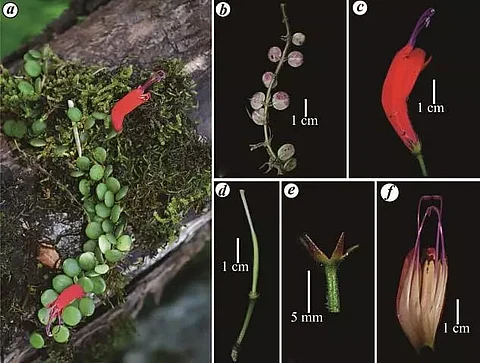
- Home
- Live Blog
- Breaking News
- Top Headlines
- Cities
- NE News
- Sentinel Media
- Sports
- Education
- Jobs

OUR CORRESPONDENT
ITANAGAR: Researchers at the Botanical Survey of India (BSI) have recently rediscovered a rare plant from Hayuliang and Chipru regions of the remote Anjaw district in Arunachal Pradesh, after 100 years.
The Indian lipstick plant (Aeschynanthus Monetaria Dunn) was first identified by British botanist Stephen Troyte Dunn in 1912, based on the plant samples gathered from Arunachal Pradesh by another English botanist, Isaac Henry Burkill.
The recent discovery was published in the Current Science journal authored by Krishna Chowlu, scientist with the Arunachal Pradesh Regional Centre of BSI and her co-author Gopal Krishna.
As per the abstract of the Current Science journal, the genus name Aeschynanthus is derived from the Greek aischyne or aischyn, which means shame or to feel embarrassed, respectively, and anthos, which means flower, alluding to the generally red-colored corolla.
"Due to the appearance of tubular red corolla, some of the species under the genus Aeschynanthus are called lipstick plants," Chowlu said in the publication.
During floristic studies in Arunachal Pradesh, Chowlu collected a few interesting specimens of Aeschynanthus from Hyuliang and Chipru of the Anjaw district in December, 2021.
A review of the relevant literature, as well as a critical study of fresh specimens and digital photographs of specimens in the Kew Herbarium Catalogue, confirmed that the specimens were A monetaria, which had never been obtained from India since Burkill in 1912.
Such plants can be found in moist and evergreen forests, at elevations ranging from 543 to 1,134 metres.
Aeschynanthus monetaria Dunn is morphologically unique and distinct among all the Aeschynanthus species known in India, with its fleshy orbicular leaves with greenish upper surface and purplish-green lower surface. The specific epithet monetaria means 'mint-like', alluding to the appearance of its leaves.
The plant grows in moist and evergreen forests. The flowering and fruiting are from October to January.
This species is poorly represented in Indian herbaria despite the fact that several Indian botanists have explored this region well since the 1970s. There is only a single representative specimen of this species available at the Central National Herbarium, an evidence of its extremely rare distribution in India.
"Landslides are frequent in the Anjaw district of Arunachal Pradesh. Developmental activities such as broadening of roads, construction of schools, new settlements and markets, and jhum cultivation are some of the major threats to this species in Arunachal Pradesh," Chowlu mentioned in the abstract of the Current Science journal.
"Both ex-situ and in-situ conservation is required since most of the Aeschynanthus require microhabitat," she added.
The species has been provisionally assessed here as 'Endangered', following the guidelines of IUCN.
There have been lots of rediscoveries of various species in Arunachal, which speaks about the rich biodiversity of the State, but experts say more dedicated explorations are needed to unravel more, Chowlu said.
Also Watch: Union Home Minister Amit Shah being welcomed at an Indo-Bangladesh Border Outpost in Mankachar